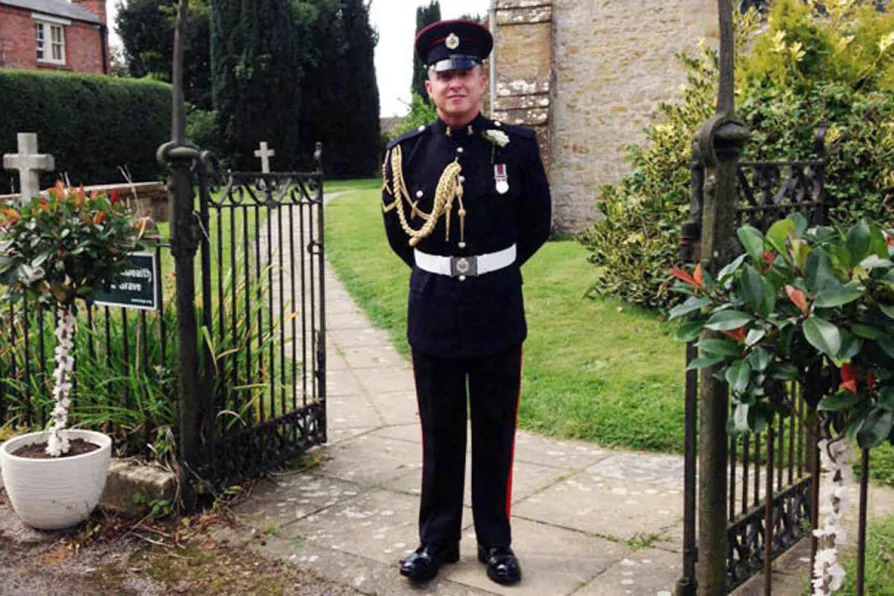
 Lance Corporal George Partridge
Lance Corporal George Partridge
A SOLDIER who drowned on a diving course was sent underwater with equipment that the military knew to be faulty, an investigation has found.
Lance Corporal George Partridge was 27 when he died at the National Dive Centre in Tidenham, Gloucestershire, on March 26 last year.
His wife Zoe was expecting their first child.
An official Royal Navy report on his death has found that soldiers on the course were using radios to communicate with their instructors while underwater, but the equipment was “culturally accepted as being unreliable.”
The radios malfunctioned so often that “only one dive out of over 30 during the course was routinely cited as having reliable communications.”
Investigators later found that LCpl Partridge’s radio had a broken cable.[[{"fid":"15203","view_mode":"inlineright","fields":{"format":"inlineright","field_file_image_alt_text[und][0][value]":"The broken radio cable","field_file_image_title_text[und][0][value]":false},"link_text":null,"type":"media","field_deltas":{"1":{"format":"inlineright","field_file_image_alt_text[und][0][value]":"The broken radio cable","field_file_image_title_text[und][0][value]":false}},"attributes":{"alt":"The broken radio cable","class":"media-element file-inlineright","data-delta":"1"}}]][[{"fid":"15204","view_mode":"inlineright","fields":{"format":"inlineright","field_file_image_alt_text[und][0][value]":"Lance Corporal George Partridge's mask with built-in radio","field_file_image_title_text[und][0][value]":false},"link_text":null,"type":"media","field_deltas":{"2":{"format":"inlineright","field_file_image_alt_text[und][0][value]":"Lance Corporal George Partridge's mask with built-in radio","field_file_image_title_text[und][0][value]":false}},"attributes":{"alt":"Lance Corporal George Partridge's mask with built-in radio","class":"media-element file-inlineright","data-delta":"2"}}]]
They also warned that the course, designed by defence firm Babcock, had “poorly written documentation.”
The syllabus was “poor both in terms of diligence, accuracy of included information and in the quality of direction to the instructional staff” and sometimes “woefully short” on technical details.
Students struggled to tell when their air supplies were running out and there were problems with activating reserve tanks.
Investigators found “overlap with previous accident reports,” echoes of a “near miss” the year before and signs that a similar incident could happen again because lessons had not been learnt.
They made over 50 recommendations and concluded that the seven-week course “does not adequately prepare the novice to dive safely below 10m.”
On the day LCpl Partridge died, the novice divers were expected to swim down along a rope to reach a submerged helicopter some 27 metres below the surface.
Once there, they had to speak via radio to their instructors, who were waiting on a pontoon, before returning to the surface.
Another student saw LCpl Partridge reach the helicopter, but when he did not resurface, a rescue diver jumped in.
The emergency swimmer found LCpl Partridge lying 24m down with his face mask off.
He was immediately brought back to the surface, but medics were unable to resuscitate him.
A post-mortem identified “sudden death in adults” as the cause of death and a pathologist said that LCpl Partridge had had a rare heart anomaly which was undiagnosed and hard to detect.
The finding will surprise those who knew him as an “extremely fit” soldier who had received a prize for being the fittest recruit on his army basic training course.
He also played rugby and football for his regiment, the Wiltshire-based 26 Engineers.
However, investigators claim that he had collapsed twice while on a commando course and had pushed himself to exhaustion on two other fitness tests, which could have indicated an underlying issue.
On the fatal dive, they believe that he ran out of air at “almost exactly the same moment” that his heart failed.
Their report states: “The course design placed him in a position where he did not have the intuitive understanding or experience of diving at this depth and was not prepared for the task as well as could have been expected.
“He was using equipment that in areas was unreliable or had design flaws, which compounded the situation.
“Given the evidence available, it is almost certain that, even without his heart anomaly, LCpl Partridge would have had a serious occurrence on this dive.”
They concluded it was “more likely than not that LCpl Partridge firstly ran out of accessible/usable air through using up all the air in both the main and emergency cylinders.
“As soon as his air supply ceased, heart failure and death were virtually coincident immediately after the conscious removal of his mask underwater.
“The triggers that precipitated LCpl Partridge’s heart attack, immediately after he removed his mask, were more likely to be factors such as cold shock and the mental shock of running out of useable air.”
In light of this report, the Royal Navy’s fleet commander has now launched a review to “tighten up” all military diving activity.
The study will be led by an independent civilian with diving and safety expertise.
Gloucestershire coroner’s office will also conduct an inquest into LCpl Partridge’s death, although no date has yet been set.
The issue of “sudden death” among troops on training course will come under scrutiny at another inquest, taking place in Birmingham in October, which will examine the death of Corporal Joshua Hoole.
The army claims that he died from sudden arrhythmogenic death syndrome while on a fitness test in the Brecon Beacons during a heatwave in 2016.
His father, a former sergeant major, disputes that explanation.
A Royal Navy spokesperson told the Morning Star: “Our thoughts remain with Lance Corporal George Partridge’s family and friends at this difficult time.
“The recommendations in the Service Inquiry have been accepted and work is underway to implement them, including working on a Defence Military Diving Review.”

















